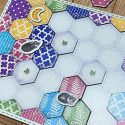‘Calico’ Board Game Review

Cats seem to be making quite an impression in the board gaming world lately. The Isle of Cats is one example that I spent a lot of time with last year, and Twitter seems awash with cats in box lids and cats making cameo appearances in games with themes of all kinds. Calico is a game that, like The Isle of Cats, actually builds its theme around cats – albeit only because cats love calico quilts, which are (as you will have guessed) the actual theme.
Everything in Calico is pretty abstract though, so whilst the players will be placing hexagonal tiles into a lovely, double-thick player board and putting cat and button tokens on top of them, the real reason that they’ll be doing so is for one simple reason; points. Points win prizes in board games, and in Calico, the rules are no different. Each player board is set up with three random scoring tiles (or not, if you choose the family mode) that detail a series of objectives that relate to the hexagons placed next to them. These objectives are fulfilled by placing the hexagons of different patterns and kinds in such a way as to meet the objective.
These randomised scoring conditions, in addition to the cats that can be “attracted” to certain other pattern combinations, are what score. Buttons placed on groups of coloured pieces also provide points, but this is more like a “consolation prize” than the main event. There are several different patterns and the same number of colours among all the pieces, and each cat is drawn to a pattern that is also randomised during setup. Somewhere between the scoring objectives (of which there are always three per player board), the buttons (placed on groups of three of the same-coloured tiles) and the cats (placed on pattern combinations that they like), Calico is an absolute brain burner.
Do not let the bright, cute and warm theme of Calico fool you – this is one of the most thoughtful and mentally taxing games that I’ve played in a long time, despite having an incredibly simple turn structure. In fact, all a player must do on their turn is place a single tile (from a hand of two) on their board – adding a cat or a button if applicable and desirable – and then draw a new tile. The new tile is chosen from three placed face up on the table for all to see, and when one is taken in this way, the player taking it will then replenish the market with a new one from a lovely little bag that comes with the game.
This gives Calico one of my favourite styles of gameplay – that of a simple set of mechanics with a very, very challenging puzzle within the game itself. You can teach Calico to someone in literally a minute or two, but learning the nuances of how best to score – determining whether to use a group to attract a cat, score towards and objective or add a button – is really tough. The scoring objectives make demands such as “of the six tiles surrounding this one, three must be of one pattern, two of another, then one of a third pattern.” Others require two of each of three different patterns. Sound simple? What if there were bonus points for repeating the same sequence with the tile colours as well?
Actually getting the tiles you need from the shared market is challenging enough because the variety of colours and patterns amounts to a large variety, but then choosing to place what you do get becomes even more complex because each board is small enough to create contention right from the first turn. Often, completing an objective might mean “disrupting” a pattern that might otherwise attract a cat, whilst placing a button is very simple, but it blocks tiles for cat placement and therefore needs to be done with caution. In the family mode, the objective tokens are placed face down, leaving younger or newer players to focus on cats and buttons only – which is much simpler.
And so here we have a beautifully produced, modestly sized box that has the clear, simple rules and modes to suit different levels of experience, whilst also offering a really crunchy, challenging experience for those who want it. The teach is clear and simple, the learning process smooth and rewarding over time, and the end result is a game that is pretty fast and fluid, but filled with interesting decisions. If I have one criticism, it is only that the players have no way to interact with each other beyond simply “hate drafting” the tiles that others obviously want. In a game as tightly wound as this, however, you’ll rarely have the space to play with too much focus on others – except when you can see no good option for your own quilt.
Overall, Calico is a really gorgeous, well rounded addition to any shelf. It’s simple gameplay and complex decision space is welcomed by most players, as is the lack of direct interaction that means the game remains generally friendly. I love playing Calico with my young children in family mode, and with my wife in the more complex mode. At less than an hour per game, Calico is a pretty light abstract experience, but it is one that I think I will continue to enjoy for some time to come.
**** 4/5
Calico is available online at 365Games.co.uk, or at your local games store. Don’t know where yours is? Try this handy games store locator.

















































